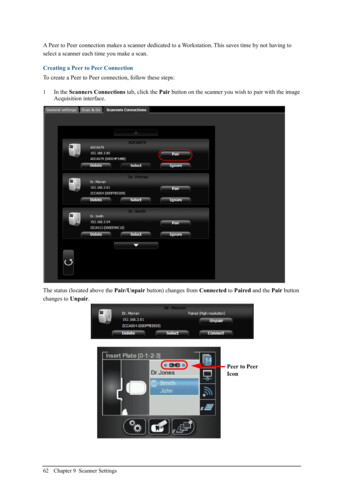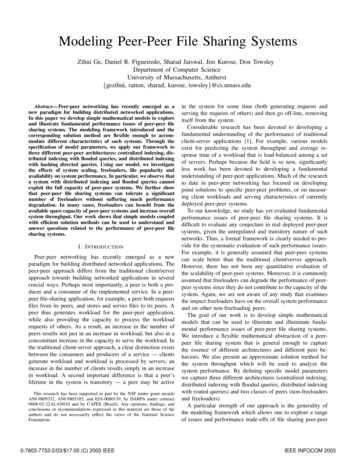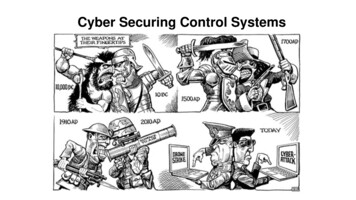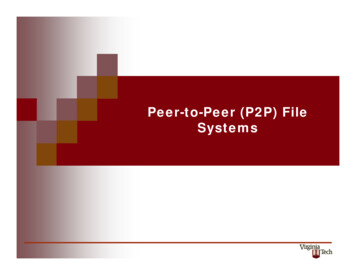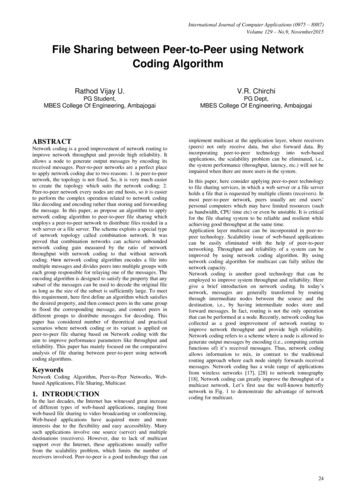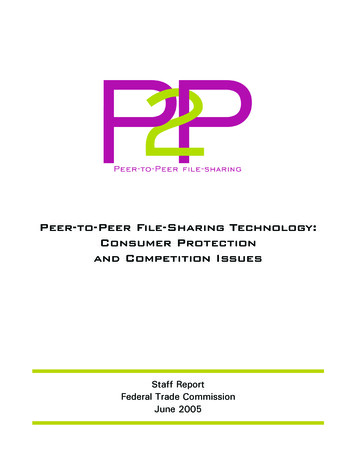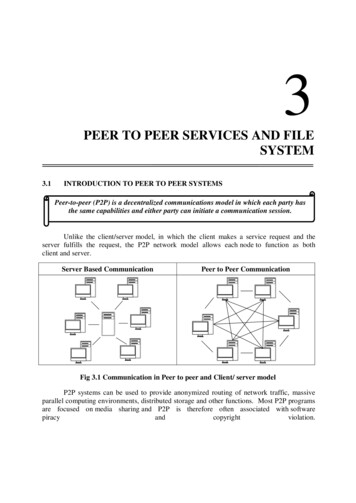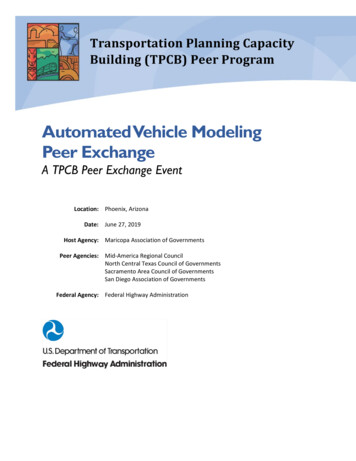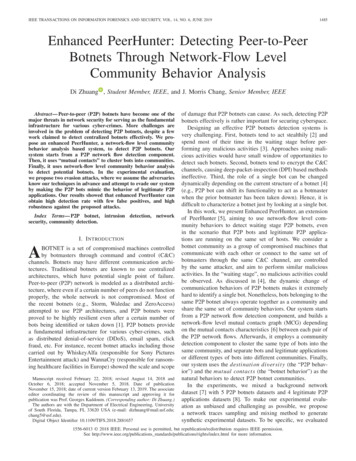
Transcription
IEEE TRANSACTIONS ON INFORMATION FORENSICS AND SECURITY, VOL. 14, NO. 6, JUNE 20191485Enhanced PeerHunter: Detecting Peer-to-PeerBotnets Through Network-Flow LevelCommunity Behavior AnalysisDi Zhuang , Student Member, IEEE, and J. Morris Chang, Senior Member, IEEEAbstract— Peer-to-peer (P2P) botnets have become one of themajor threats in network security for serving as the fundamentalinfrastructure for various cyber-crimes. More challenges areinvolved in the problem of detecting P2P botnets, despite a fewwork claimed to detect centralized botnets effectively. We propose an enhanced PeerHunter, a network-flow level communitybehavior analysis based system, to detect P2P botnets. Oursystem starts from a P2P network flow detection component.Then, it uses “mutual contacts” to cluster bots into communities.Finally, it uses network-flow level community behavior analysisto detect potential botnets. In the experimental evaluation,we propose two evasion attacks, where we assume the adversariesknow our techniques in advance and attempt to evade our systemby making the P2P bots mimic the behavior of legitimate P2Papplications. Our results showed that enhanced PeerHunter canobtain high detection rate with few false positives, and highrobustness against the proposed attacks.Index Terms— P2P botnet, intrusion detection, networksecurity, community detection.I. I NTRODUCTIONABOTNET is a set of compromised machines controlledby botmasters through command and control (C&C)channels. Botnets may have different communication architectures. Traditional botnets are known to use centralizedarchitectures, which have potential single point of failure.Peer-to-peer (P2P) network is modeled as a distributed architecture, where even if a certain number of peers do not functionproperly, the whole network is not compromised. Most ofthe recent botnets (e.g., Storm, Waledac and ZeroAccess)attempted to use P2P architectures, and P2P botnets wereproved to be highly resilient even after a certain number ofbots being identified or taken down [1]. P2P botnets providea fundamental infrastructure for various cyber-crimes, suchas distributed denial-of-service (DDoS), email spam, clickfraud, etc. For instance, recent botnet attacks including thosecarried out by WhiskeyAlfa (responsible for Sony PicturesEntertainment attack) and WannaCry (responsible for ransoming healthcare facilities in Europe) showed the scale and scopeManuscript received February 22, 2018; revised August 14, 2018 andOctober 6, 2018; accepted November 5, 2018. Date of publicationNovember 15, 2018; date of current version February 13, 2019. The associateeditor coordinating the review of this manuscript and approving it forpublication was Prof. Georges Kaddoum. (Corresponding author: Di Zhuang.)The authors are with the Department of Electrical Engineering, Universityof South Florida, Tampa, FL 33620 USA (e-mail: dizhuang@mail.usf.edu;chang5@usf.edu).Digital Object Identifier 10.1109/TIFS.2018.2881657of damage that P2P botnets can cause. As such, detecting P2Pbotnets effectively is rather important for securing cyberspace.Designing an effective P2P botnets detection systems isvery challenging. First, botnets tend to act stealthily [2] andspend most of their time in the waiting stage before performing any malicious activities [3]. Approaches using malicious activities would have small window of opportunities todetect such botnets. Second, botnets tend to encrypt the C&Cchannels, causing deep-packet-inspection (DPI) based methodsineffective. Third, the role of a single bot can be changeddynamically depending on the current structure of a botnet [4](e.g., P2P bot can shift its functionality to act as a botmasterwhen the prior botmaster has been taken down). Hence, it isdifficult to characterize a botnet just by looking at a single bot.In this work, we present Enhanced PeerHunter, an extensionof PeerHunter [5], aiming to use network-flow level community behaviors to detect waiting stage P2P botnets, evenin the scenario that P2P bots and legitimate P2P applications are running on the same set of hosts. We consider abotnet community as a group of compromised machines thatcommunicate with each other or connect to the same set ofbotmasters through the same C&C channel, are controlledby the same attacker, and aim to perform similar maliciousactivities. In the “waiting stage”, no malicious activities couldbe observed. As discussed in [4], the dynamic change ofcommunication behaviors of P2P botnets makes it extremelyhard to identify a single bot. Nonetheless, bots belonging to thesame P2P botnet always operate together as a community andshare the same set of community behaviors. Our system startsfrom a P2P network flow detection component, and builds anetwork-flow level mutual contacts graph (MCG) dependingon the mutual contacts characteristics [6] between each pair ofthe P2P network flows. Afterwards, it employs a communitydetection component to cluster the same type of bots into thesame community, and separate bots and legitimate applicationsor different types of bots into different communities. Finally,our system uses the desti nati on di ver si t y (the “P2P behavior”) and the mutual contacts (the “botnet behavior”) as thenatural behaviors to detect P2P botnet communities.In the experiments, we mixed a background networkdataset [7] with 5 P2P botnets datasets and 4 legitimate P2Papplications datasets [8]. To make our experimental evaluation as unbiased and challenging as possible, we proposea network traces sampling and mixing method to generatesynthetic experimental datasets. To be specific, we evaluated1556-6013 2018 IEEE. Personal use is permitted, but republication/redistribution requires IEEE permission.See http://www.ieee.org/publications standards/publications/rights/index.html for more information.
1486IEEE TRANSACTIONS ON INFORMATION FORENSICS AND SECURITY, VOL. 14, NO. 6, JUNE 2019our system with 100 synthetic experimental datasets thateach contains 10,000 internal hosts. We implemented ourP2P network flow detection component using MapReduceframework, which dramatically reduced the number of hostssubject to analysis by 99.03% and retained most of the P2Phosts. Also, the MapReduce design and implementation ofour system could be deployed on cloud-computing platforms(e.g., Amazon EC2), which ensures the scalability of oursystem (i.e., processing an average of 97 million networkflows in about 20 minutes). To summarize, our work has thefollowing contributions: We present a novel, effective and efficient network-flowlevel community behavior analysis based system, EnhancedPeerHunter, which is capable of detecting P2P botnetswhen (a) botnets are in their waiting stage; (b) the C&C channel has been encrypted; (c) the botnet traffic are overlappedwith legitimate P2P traffic on the same host; and (d) nonestatistical traffic patterns are known in advance (unsupervised). We experimented our system using a wide range of parameter settings. With the best parameter settings, our systemachieved 100% detection rate with zero false positive. We propose two evasion attacks (i.e., passive and activemimicking legitimate P2P application attacks), where weassume the adversaries know our techniques in advance andattempt to evade our system via instructing P2P bots to mimicthe behavior of legitimate P2P applications. The experimentresults showed that our system is robust to both attacks. We compared Enhanced PeerHunter with PeerHunter [5](i.e., our previous work) and Zhang et al. [2]. Extensiveexperiments were conducted to show that (a) our systemoutperforms Zhang et al. [2] in terms of the detection rateof different botnets, the overall precision, recall and falsepositives, and (b) our system is more robust to MMKL attackscompared with PeerHunter [5] and Zhang et al. [2].The rest of this paper is organized as follows: Section IIpresents the related work. Section III explains the motivationand details of the features applied in our system. Section IVdescribes the system design and implementation details.Section V presents the experimental evaluation. Section VIdiscusses the evasions and possible solutions, deploymentand the potential extensions of our system. Section VIIconcludes.II. R ELATED W ORKTo date, a few methods attempting to detect P2P botnetswere proposed [2]–[6], [8]–[14]. From the data perspective, recent approaches can be divided into two categories [14]: payload-based and flow-based. Payload-basedsystems [9], [15], [16] use payload content and header information of network packets to detect botnets. For instance,BotHunter [9] is a well-known packet inspecting bot detectionsystem that relies on a modified Snort [17] (i.e., a rulebased intrusion detection system that requires the accessto the full payload) to detect potential malicious activitiesand further identify infected hosts. Lu et al. [15] proposedto use decision tree models trained on the n-gram featuresextracted from the network traffic payload to detect botnets.Wang et al. [16] proposed to use lexical features of HTTPheader (TCP payload) to discover malicious behaviors ofAndroid botnets.Flow-based systems [2]–[6], [8], [10]–[14], [18], [19] useheader information of network packets (i.e., network flowcharacteristics) to capture botnets behaviors. Compared withpayload-based systems, flow-based systems use less information from the network packets. Since recent botnets tend to useencryption to hide their payload information from the detectionsystems, most of the packet-based systems that applyingdeep packet inspection (DPI) on the payload information(e.g., BotHunter [9]) will be foiled. Zhang et al. [20] proposedto add a high-entropy flow detector into BotHunter to detectbots, when part of the packets payloads of botnets’ networkflows are encrypted. Their assumption is that the presenceof high-entropy flows (detected from the encrypted packetspayloads) together with existing botnets events (detected fromthe non-encrypted packets payloads by BotHunter) couldidentify botnets using encrypted network traffic. However,if all the packets payloads are encrypted [14], it will behard for their approach to perform. The flow-based detectionsystems have advantage over the packet-based systems thatapplying deep packet inspection (DPI) on the payload information (e.g., BotHunter [9]) given that they can be appliedto encrypted traffic. Some flow-based systems applied one orseveral different supervised machine learning algorithms ona set of well extracted network flow features to model thebotnets behaviors. For instance, Jianguo et al. [21] appliedthree supervised machine learning algorithms (i.e., SVM,Logistic Regression and Neural Network) on network flowfeatures extracted from Netmate and Tranalyzer to detectbotnets. They obtained very high performance metrics, whileemploying a fully labelled dataset. Khanchi et al. [19] proposed an approach using genetic programming and ML ondata streams to detect botnets flows. However, since most ofthe supervised ML-based approaches usually generate modelsthat are focusing on specific types of botnets (existing in thetraining data), those approaches will not be effective to detectbotnets not appeared in the training data (unknown botnets).Some flow-based systems utilized a combination of different heuristics to model P2P botnets behaviors. For instance,Botgrep [10] proposed to detect P2P botnets through localizing structured communication graphs, where they foundthat the communication graph of P2P applications have fastconvergence time of random walks to a stationary distribution. However, their method can only identify structuredcommunication subgraphs, rather than ensure those subgraphscontaining P2P botnets. Entelecheia [3] proposed to use asynergistic graph-mining approach on a super-flow graphbuilt from network flow features (i.e., volume per hour,duration per flow) to identify a group of P2P bots, wherethey claimed that P2P botnet network flow tend to have lowvolume and long duration. Group or community behaviorbased methods [4]–[6], [11] considered the behavior patternsof a group of bots within the same P2P botnet community.Coskun et al. [6] developed a P2P botnets detection approachthat started from building a mutual contacts graph of thewhole network, then attempted to use “seeds” (known bots)to identify the rest of botnets. However, it is impractical
ZHUANG AND CHANG: ENHANCED PEERHUNTER: DETECTING P2P BOTNETSto have a “seed” in advance. Similar to the idea of usingmutual contacts graph, Ma et al. [22] proposed to use thecoexistence of domain cache-footprints distributed in networksthat participate in the outsourcing service (i.e., coexistencegraph) to detect malicious domains. Yan et al. [4] proposeda group-level behavior analysis based P2P botnets detectionmethod, where they started from clustering P2P hosts intogroups, and then used supervised machine learning methods(e.g., SVM) to identify bots through a set of group-levelbehavior features. Since their approach relied on supervisedclassification methods (e.g., SVM) which required to train themodel of each botnet on fully labelled dataset in advance,it would be hard for their method to detect unknown botnets.Chen et al. [23] applied three unsupervised machine learningalgorithms (i.e., self-organising map, local outlier factor andk-NN outlier) to build a normal behavior profile to detectbotnet. They obtained a very high detection rate (91.3%), butwith inherited high false positive rates due to the nature ofthe unsupervised ML algorithms employed. PeerHunter [5],our previous work, proposed to use the host level communitybehavior analysis to detect P2P botnets, which did not considerthe scenario that P2P bots and legitimate P2P applicationscould run on the same set of hosts. Zhang et al. [2] proposeda scalable botnet detection system capable of detecting stealthyP2P botnets (i.e., in the waiting stage), where no knowledgeof existing malicious behavior was required in advance. Theyalso claimed to work in the scenario that the botnet traffic areoverlapped with the legitimate P2P traffic on the same host.However, their experimental dataset was slightly biased andless challenging. For example, in their dataset, the numberof bots was twice as many as the number of legitimate P2Phosts, which was much easier for bots to form clusters thanlegitimate P2P hosts.In this work, we present Enhanced PeerHunter, a networklevel flow-based system that relies on community behavioranalysis to detect P2P botnets. We compared Enhanced PeerHunter with PeerHunter [5] and Zhang et al. [2] on a morechallenging and comprehensive experimental datasets, andshowed that our system outperforms both systems in termsof detection rate, false positives and the performance underthe proposed mimicking legitimate P2P application attacks.III. BACKGROUND AND M OTIVATIONIn this section, we investigate the characteristics being usedto detect P2P network traffic, and introduce the concept of“mutual contacts”, which motivated us to formulate the P2Pbotnet detection problem as a network community detectionproblem. Also, we explore the P2P botnet community behaviors being used to identify botnets communities. To demonstrate the features discussed in this section, we conducted somepreliminary experiments using the dataset shown in Table IIIand Table IV. Table I shows the notations and descriptions,and Table II shows the measurements of features.A. P2P Network CharacteristicsDue to the nature of P2P networks, P2P hosts usually communicate with their peers through IP addresses directly, without any queries from DNS services [24], namely, non-DNSconnections (NoDNS). Also, peer churn is another typical1487TABLE IN OTATIONS AND D ESCRIPTIONSTABLE IIM EASUREMENTS OF F EATURESbehavior in P2P networks [25], which results in a significant number of failed connections in P2P network flow.Furthermore, due to the decentralized nature of P2P network,a P2P host usually communicates with peers distributed in alarge range of physical networks, which results in destinationdiversity (DD) [8] of P2P management network flow (MNF).To be clearer, P2P host generate two types of network flow:(1) management network flow, which maintains the functionand structure of the P2P network, and (2) other network flow,such as data-transfer flow, which does not necessarily have theP2P network characteristics. The P2P network flow mentionedin this section and the rest all refers to P2P MNF.Zhang et al. [2] proposed to remove a decent number ofnon-P2P network flow using NoDNS, and then performed afine-grained P2P hosts detection using DD. Based on theirexperiment results, DD plays a much more important role indetecting P2P hosts than NoDNS. Therefore, in this work,we decided to only use DD to simplify and speed up theP2P network flow detection procedure. In addition, we usedthe number of distinct /16 IP prefixes of each host’s networkflow, rather than BGP prefix used in [2] to approximate DD,since /16 IP prefix is a good approximation of networkboundaries. For instance, it is very likely that two IP addresseswith different /16 IP prefixes belong to two distinct physicalnetworks. This is also supported by Table II, which shows thenetwork flow in a P2P network spreading across many distinctphysical networks according to the number of /16 IP prefixes.B. Mutual ContactsThe mutual contacts (MC) between a pair of hosts is a setof shared contacts between them [6]. Consider the networkillustrated in Fig. 1a which contains an internal network (A, B,C, D and E) and an external network (1, 2, 3, 4 and 5). A linkbetween a pair of hosts means communication between them.In Fig. 1a, 1, 2 are the mutual contacts shared by A, B.
1488Fig. 1.IEEE TRANSACTIONS ON INFORMATION FORENSICS AND SECURITY, VOL. 14, NO. 6, JUNE 2019Illustration of network (a) and its mutual contacts graph (b).Mutual contacts are the natural characteristic of P2P botnet.Compared with legitimate hosts, a pair of bots within the sameP2P botnet has higher probability to share mutual contacts [6].Because bots within the same P2P botnet tend to receive thesame C&C messages from the same set of botmasters [26].Moreover, in order to prevent bots (peers) from churning,the botmaster must check each bot periodically, which resultsin a convergence of contacts among peers within the samebotnet [2]. However, since bots from different botnets arecontrolled by different botmasters, they will not share manymutual contacts. A pair of Legitimate hosts may have a smallset of mutual contacts, since nearly all hosts communicate withsome popular servers, such as google.com, facebook.com [6].Furthermore, the host pairs running the same P2P applicationsmay also result in a decent ratio of mutual contacts, if theycommunicate with the same set of peers by coincidence.However, in practice, legitimate P2P hosts with differentpurposes will not search for the same set of peers. As such,we can use mutual contacts to cluster the bots within thesame botnet, and separate P2P botnets from legitimate P2Papplications.The basic idea of using mutual contacts is to build a mutualcontacts graph (MCG) as shown in Fig. 1, a host level MCG,where A, B are linked together in Fig. 1b, since they havemutual contacts 1, 2 in Fig. 1a. Similarly, C, D, E are linkedto each other in Fig. 1b, since every pair of them shareat least one mutual contacts in Fig. 1a. More details aboutnetwork-flow level MCG is discussed in Section IV-B.C. Community Behavior AnalysisDue to the dynamic changes of a single bot’s communication behavior [4], it would be extremely hard to identify asingle bot. However, bots within the same P2P botnet alwayswork together as a community, thus, should have distinguishable community behaviors. We consider three types ofcommunity behaviors: (a) flow statistical feature, (b) numericalcommunity feature and (c) structural community feature.1) Flow Statistical Feature: Botnet detection methods usingflow statistical features, have been widely discussed [2]–[5].For the MNFs of a specific P2P application, most of itsstatistical patterns depend on its P2P network protocol. However, the statistical patterns of other network flows, such asdata-transfer flow, are usually situation-dependent, which varya lot even in the same P2P network. In this work, we use theingoing and outgoing bytes-per-packets (BPP) of MNFs in oneP2P network as its community flow statistical feature.2) Numerical Community Feature: We consider twonumerical community features: average destinationdiversity ratio (AVGDDR) and average mutual contactsratio (AVGMCR).a) Average destination diversity ratio: This captures the“P2P behavior” of P2P botnets. The destination diversity (DD)of a P2P host is the number of distinct /16 IP prefixes ofits network flows’ destination IPs. The destination diversityratio (DDR) of each host is its DD divided by the total numberof distinct destination IPs of its network flows. Due to thedecentralized nature of P2P networks, P2P network flow tendto have higher DDR than non-P2P network flow. Furthermore,network flow from P2P botnets usually have higher AVGDDRthan network flow from legitimate networks. Network flowfrom bots within the same botnet tend to have similar DDR,since those bots are usually controlled by machines, ratherthan humans. However, the destinations of legitimate P2Pnetwork flow are usually user-dependent, which result in theirDDR varying greatly from user to user. Besides, our approachaims to cluster bots within the same botnets together, ratherthan attempting to cluster the legitimate hosts. Therefore,legitimate communities might contain both P2P hosts and nonP2P hosts, leading to lower AVGDDR. As shown in Table II,both legitimate hosts and bots spread across a wide range ofdistinct networks. However, most of the botnets have higherAVGDDR than legitimate applications, except Sality.b) Average mutual contacts ratio: This captures the “botnet behavior” of P2P botnets. The mutual contacts ratio (MCR)between a pair of hosts is the number of mutual contactsbetween them, divided by the number of total distinct contactsof them. This is based on three observations: (a) P2P botnetsare usually formed by at least two bots, otherwise theycannot act as a group, (b) the MCR of a pair of bots withinthe same botnet is much higher than the MCR of a pairof legitimate applications or a pair of bots from differentbotnets, and (c) each pair of bots within the same botnethas similar MCR. Thus, we define AVGMCR as the averageMCR among all pairs of hosts within one network community.As shown in Table II both botnets and certain legitimatenetwork communities have a considerable number of mutualcontacts. That is because those legitimate communities havemuch more “base” contacts than botnets. However, botnetshave much higher AVGMCR.3) Structural Community Feature: This captures the structural characteristics of a botnet. As discussed above, every pairof bots within the same botnet tends to have a considerablenumber or ratio of mutual contacts. If we consider each hostas a vertex and link an edge between a pair of hosts when theyhave mutual contacts, the bots within the same botnet tend toform cliques. On the contrary, the contacts of different legitimate hosts usually diverge into different physical networks.Thus, the probability that legitimate communities form certaincliques is relatively low. Then, we can consider P2P botnetsdetection as a clique detection problem, which detects cliquesfrom a given network with certain requirements. However,since clique detection problem is NP-complete, we cannot
ZHUANG AND CHANG: ENHANCED PEERHUNTER: DETECTING P2P BOTNETSFig. 2.1489System overview.Algorithm 1 P2P Network Flow Detection1: function M AP ([i psrc , i pdst , pr oto, bppout , bppin ])2:K ey [i psrc , pr oto, bppout , bppin ]3:V alue i pdst4:output (K ey, V alue)5: end function6: function R EDUCE (K ey, V alue[ ])7:k K ey8:ddk Ø9:for v V alue[ ] do10:ddk ddk {v}11:end for12:if ddk dd then13:for v V alue[ ] do14:output (k, v)15:end for16:end if17: end functiondirectly apply such method to detect botnets, without any preprocessing. We propose to combine all three botnet communitybehaviors, and use the previous two community behaviors asthe “preprocessing” of the clique detection problem.IV. S YSTEM D ESIGNEnhanced PeerHunter has three components, as shownin Fig. 2, that work synergistically to (a) detect P2P networkflow, (b) construct the network-flow level mutual contactsgraph, and (c) detect P2P botnets.A. P2P Network Flow DetectionThis component aims to detect network flow that engagein P2P communications using the features described inSection III-A. The input is a set of 5-tuple network flow[i psrc , i pdst , pr oto, bppout , bppin ], where i psrc is the sourceIP, i pdst is the destination IP, pr oto is either tcp or udp,and bppout and bppin are outgoing and ingoing bytes-perpackets (BPP) statistics. First, we group all network flowsF { f 1 , f 2 , . . . , f k } into flow clusters FC {FC1 , FC2 ,. . . , FCm } using the 4-tuple [i psrc , pr oto, bppout , bppin ].Then, we calculate the number of distinct /16 prefixes of i pdst(destination diversity) associated with each flow cluster, ddi D D(FCi ). If ddi is greater than a pre-defined threshold dd ,we consider FCi as a P2P MNF cluster, and its source hostsas P2P hosts. We retain all the network flows within the P2PMNF clusters for the next component, and eliminate all theother network flows. As shown in Algorithm 1, we designedthis component using a MapReduce framework [27]. For amapper, the input is a set of 5-tuple network flow, and theoutput is a set of key-value pairs, where the key is the4-tuple [i psrc , pr oto, bppout , bppin ], and the value is itscorresponding i pdst . For a reducer, the input is the set ofkey-values pairs that outputs by the mapper. Then, the reduceraggregates all values with the same key to calculate the DDof each flow cluster, and finally output the detected P2P MNFbased on dd .B. Network-Flow Level Mutual Contacts Graph ExtractionThis component aims to extract mutual contactsgraph (MCG) using the network-flow level mutual contacts.We call a pair of P2P network flow clusters are the sametype, if they have the same 3-tuple [ pr oto, bppout , bppin ].As illustrated in Fig. 3, each host might contain one type orseveral different types of P2P network flow clusters generatedby either P2P botnets or legitimate P2P applications runningon it. If a pair of the same type of P2P network flow clustersgenerated by different hosts, have at least one (network-flowlevel) mutual contacts, we create an edge between them inthe corresponding network-flow level MCG.To be specific, the input is a set of P2P network flow clustersFC {FC1 , FC2 , . . . , FCm }, and their corresponding P2Pnetwork flows, F { f 11 , f 21 , . . ., fn11 , f 12 , f 22 , . . ., f n22 , . . .,j F C F C F C f 1 , f 2 , . . ., f n FC }, where f i denotes the flow i of FC j .The output is a MCG, G mc (V, E), where each vertexv i V represents network flow cluster FCi and has a DDRscore ddri , and each edge ei j E represents the existence ofmutual contacts between FCi and FC j and has a nonnegativeMCR weight mcri j . Algorithm 2 shows the detailed steps.First, for each P2P network flow cluster FCi , we generatea contact set Ci , that contains all the destination IPs ofits network flows. Each P2P network flow cluster FCi alsocontains a flow statistical pattern set Si , which contains allthe 3-tuple [ pr oto, bppout , bppin ] of its network flows. LetD D(Ci ) be the set of distinct /16 prefixes of all the IPs in Ci .Then, ddri and mcri j can be calculated as follows.ddri Ci C j D D(Ci ) mcri j Ci Ci C j (1)Furthermore, as discussed in Section III-C.1, the networkflows from different hosts (or network flow clusters) withinthe same network communities (generated by the same type ofP2P botnet or legitimate P2P application) should have similarstatistical patterns. Thus, for each pair of input P2P networkflow clusters, say FCi and FC j , we calculate the intersectionbetween Si and S j . If Si S j Ø, then there should be noedge between FCi and FC j in MCG. Otherwise, they shareat least one network flow statistical pattern, and we calculatemcri j as shown in equation (1). Let mcr be a pre-definedthreshold. Then, if mcri j mcr , there is an edge betweenFCi and FC j , with weight mcri j . Otherwise, there is no edgebetween FCi and FC j (i.e., mcri j 0).
1490IEEE TRANSACTIONS ON INFORMATION FORENSICS AND SECURITY, VOL. 14, NO. 6, JUNE 2019Fig. 3. An example of network-flow level mutual contacts graph extraction and community detection. Each triangle represents a network flow cluster, andthe same color triangles represent the same type of network flow clusters. The areas separated by the dash-dot line with different color represents differentcommunities.Algorithm 2 Network-Flow Level MCG Extractioninput: FC, F, mcroutput: G mc (V, E)1: E Ø, V Ø2: for FCi FC do3:Ci Ø4:Si Ø5: end forj6: for f i F do7:C j C j {i pdst }8:S j S j {[ pr oto, bppout , bppin ]}9: end for10: for FCi FC doD(C i ) 11:ddri D Ci 12:ver tex v i ddri 13:V V {v i }14: end for15: for FCi , FC j FC and i j do16:if Si S j Ø then C C 17:mcri j Cii C jj .18:if mcri j mcr then19:edge ei j mcri j 20:E E {ei j }21:end if22:end if23: end for24: return G mc (V, E)C. P2P Botnet DetectionThis component aims to detect P2P bots from givenMCG. First, we cluster the bots and the other hosts intotheir own communities using a community detection method.Afterwards, we detect botnet communities using numericalcommunity behavior analysis. Finally, we use structural community behavior analysis to further identify or verify each botcandidate. Algorithm 3 shows the detailed steps.1) Community Detection: Given MCG G mc (V, E), ei j E, we
Community Behavior Analysis Di Zhuang , Student Member, IEEE, and J. Morris Chang, Senior Member, IEEE Abstract—Peer-to-peer (P2P) botnets have become one of the major threats in network security for serving as the fundamental infrastructure for various cyber-crimes. More challenges are involved in the problem of detecting P2P botnets .
